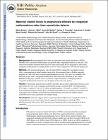| dc.contributor.author | Molloy, Anne | en |
| dc.contributor.author | Sutton, Marie | en |
| dc.date.accessioned | 2015-12-09T11:33:19Z | |
| dc.date.available | 2015-12-09T11:33:19Z | |
| dc.date.issued | 2011 | en |
| dc.date.submitted | 2011 | en |
| dc.identifier.citation | Sutton M, Mills JL, Molloy AM, Troendle JF, Brody LC, Conley M, Mc Donnell R, Scott JM, Kirke PN., Maternal folate, vitamin B12 and homocysteine levels in pregnancies affected by congenital malformations other than neural tube defects., Birth Defects Research A: Clinical and Molecular Teratology, 91, 7, 2011, 610 - 615 | en |
| dc.identifier.other | Y | en |
| dc.identifier.uri | http://hdl.handle.net/2262/75136 | |
| dc.description | PUBLISHED | en |
| dc.description.abstract | Background—
Periconceptional use of folic acid prevents most neural tube defects (NTDs).
Whether folic acid and/or multivitamins can prevent other congenital anomalies is not clear. This
study tested whether maternal blood levels of folate and vitamin B12 in pregnancies affected by
congenital malformations excluding NTDs are lower when compared to non-affected pregnancies.
Methods—
We measured pregnancy red cell folate (RCF), vitamin B12, and homocysteine
(tHcy) concentrations in blood samples taken at the first antenatal clinic in Dublin maternity
hospitals in 1986–1990 when vitamin supplementation was rare. The cases were mothers who
delivered a baby with a congenital malformation other than NTD identified by the Dublin
EUROCAT Registry; controls were a systematic sample of mothers of offspring without
congenital malformations from the same hospitals in the same time period.
Results—
The median maternal levels of RCF and tHcy did not differ significantly between cases
and controls for any of the congenital malformation groups examined (RCF: all malformations
275.9 ug/L v controls 271.2; p=0.77; tHcy: all malformations 7.5 umol/L v controls 7.6; p=0.57).
In an unadjusted analysis vitamin B12 was significantly higher in case-mothers whose babies had
cleft palate only (p=0.006), musculoskeletal malformations (p=0.034) and midline defects
(p=0.039) but not after adjustment for multiple testing.
Conclusions—
Our data suggest that low maternal folate and B12 levels or high tHcy levels in
early pregnancy are not associated with all congenital malformations excluding NTDs.
Fortification with folic acid or B12 may not have a beneficial effect in the prevention of these
anomalies. | en |
| dc.description.sponsorship | We thank the Masters and nursing staff of the Coombe Women’s University Hospital, the National Maternity
Hospital and the Rotunda Hospital for subject recruitment and Dr Zachary Johnson for assistance with case and
control identification. This research was supported by the Intramural Research Program of the
Eunice Kennedy
Shriver
National Institute of Child Health and Human Development and the Health Research Board of Ireland. | en |
| dc.format.extent | 610 | en |
| dc.format.extent | 615 | en |
| dc.language.iso | en | en |
| dc.relation.ispartofseries | Birth Defects Research A: Clinical and Molecular Teratology | en |
| dc.relation.ispartofseries | 91 | en |
| dc.relation.ispartofseries | 7 | en |
| dc.rights | Y | en |
| dc.subject | folic acid | en |
| dc.subject.lcsh | folic acid | en |
| dc.title | Maternal folate, vitamin B12 and homocysteine levels in pregnancies affected by congenital malformations other than neural tube defects. | en |
| dc.type | Journal Article | en |
| dc.contributor.sponsor | National Institutes of Health (NIH) | en |
| dc.contributor.sponsor | Health Research Board (HRB) | en |
| dc.type.supercollection | scholarly_publications | en |
| dc.type.supercollection | refereed_publications | en |
| dc.identifier.peoplefinderurl | http://people.tcd.ie/amolloy | en |
| dc.identifier.peoplefinderurl | http://people.tcd.ie/masutton | en |
| dc.identifier.rssinternalid | 78998 | en |
| dc.rights.ecaccessrights | openAccess | |
| dc.subject.TCDTheme | International Development | en |
| dc.identifier.orcid_id | 0000-0002-1688-9049 | en |
| dc.status.accessible | N | en |




